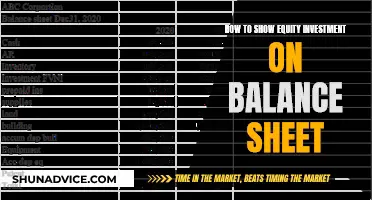
Young people are increasingly investing their money to prepare for their future. However, investing can be complicated, with a lot of new concepts and jargon to get your head around. But it doesn't have to be. Here are some tips to help you get started on your investment journey.
First, you need to have a financial plan. How much are you going to invest? For how long? What are your financial goals? Do you understand your tolerance for risk? All investments carry some risk, so it's important to do your research.
When it comes to choosing an investment account, you'll want to consider a brokerage account, a 401(k) or an individual retirement account (IRA). A brokerage account is a standard investment account that offers flexibility, but it's also a taxable account. A 401(k) is an employer-sponsored retirement plan that offers tax benefits and sometimes includes employer-matching contributions. An IRA is another option for retirement savings, with similar tax benefits to a 401(k).
Once you've chosen an account type, it's time to open your account and put money in it. You can do this through your employer or by choosing a financial institution. Decide how much money you want to invest and how often. You can invest a little bit each month and gradually increase your contributions over time.
Now it's time to pick your investments. You can choose from individual stocks and bonds, mutual funds or ETFs, or you can hire a professional manager. A diversified portfolio that includes a range of stocks and bonds will help to minimise your risk.
Finally, take the plunge and buy your investments. Remember, investing is a long-term game, so try not to get too caught up in the short-term fluctuations of the market. Review your portfolio periodically and make adjustments as needed.
What You'll Learn

Set financial goals
Setting financial goals is the first step to investing. It is important to ask yourself what you are investing for. Retirement is a common long-term goal, but you may also be saving for a house, a child's education, or a dream vacation.
Once you have a goal in mind, you can start to think about the type of account you want to use, how much money you want to invest, and what to invest it in.
If you are investing for retirement, you might consider a 401(k) plan, which is a retirement plan offered by your employer. This allows you to save a portion of your paycheck before taxes are taken out, and your employer may even match your contributions. An Individual Retirement Account (IRA) is another option for retirement savings. Depending on whether you choose a traditional or Roth IRA, your earnings will grow tax-deferred or tax-free.
If you are investing for another goal, you might consider a taxable brokerage account. These accounts are flexible and allow you to invest in a wide range of options, but you will generally have to pay taxes on any realized investment profits.
When setting financial goals, it is also important to consider your financial situation, time horizon, and risk tolerance. Figure out how much you are spending every month and how much is left over to save toward your goals. Determine how much time you will need to achieve your goals—generally, if you have many years until retirement, it is a long-term goal, whereas if you are planning to buy a home in 5 years, that is a short-term goal. The longer your time frame, the more time your money has to potentially grow.
Finally, think about the amount of market volatility and potential loss you are willing to accept. Your risk tolerance will likely vary depending on the time horizon for each of your goals. For example, if you have a long time to reach your goal, you may be comfortable taking on more risk.
India's Foreign Investment: Strategies and Allurements
You may want to see also

Choose an account type
When it comes to choosing an account type for your investments, there are several options to consider, each with its own pros and cons. Here are some of the most common types of investment accounts:
Brokerage Account
A brokerage account is a flexible investment account that offers a wide range of investment options. Anyone over the age of 18 can open a brokerage account and there are usually no restrictions on the amount of money that can be added to the account. One of the main advantages of a brokerage account is the flexibility it offers in terms of access to your funds; you generally have the option to withdraw cash from the account whenever you need to. However, it's important to note that brokerage accounts are taxable, which means you may have to pay taxes on any profits or dividends you receive.
K)
A 401(k) is an employer-sponsored retirement plan. One of the main benefits of a 401(k) is the potential for tax advantages; you can contribute to the account pre-tax, and any tax is usually only paid when you make withdrawals during retirement. Additionally, contributions to a 401(k) can lower your taxable income for the year. Many employers will also match your contributions up to a certain amount, boosting your savings further. However, there are rules and restrictions to consider, including limits on how much you can contribute and when you can withdraw funds.
Individual Retirement Account (IRA)
An Individual Retirement Account (IRA) is another option for those saving for retirement. Like a 401(k), an IRA offers tax benefits, and you may be able to get a tax deduction for the year you make a contribution. IRAs often provide more flexibility and control over your investments compared to a 401(k). For example, you may be able to contribute whenever you like and have more investment choices. However, there are rules and restrictions to consider, including eligibility requirements for tax deductions and limits on how much you can contribute and when you can withdraw funds.
Taxable Account
A taxable account, also known as a brokerage account, is a flexible investment account that is not specifically earmarked for retirement or any other specific purpose. There are no rules on contribution amounts, and you generally have the freedom to withdraw funds at any time. However, taxable accounts do not offer the same tax benefits as retirement accounts, so you may have to pay taxes on any profits or dividends you receive.
Understanding the Efficient Frontier: Maximizing Investment Portfolio Returns
You may want to see also

Open an account
Now that you know what kind of account you want and have chosen an account provider, you need to open the account. This is a straightforward process, much like opening a bank account. You'll need to provide some personal information, choose how to fund the account, and transfer the money, typically from a checking or savings account.
Often, you can open an account with no initial deposit. Of course, you only start investing once you add money to the account and buy investments, and it's a good idea to do this regularly for the best results. You can set up automatic transfers from your checking account to your investment account or even directly from your paycheck if your employer allows that.
If you're opening a 401(k), you contribute through payroll deductions, meaning the money is taken out of your paycheck automatically. You decide how much of your pay to contribute. If your employer offers matching contributions, consider investing at least enough to capture the full amount of the match. For example, if your employer offers a dollar-for-dollar match up to 3%, you would contribute 3% to take full advantage.
If you're opening an IRA or brokerage account, you can start by depositing a chunk of money and then add to that when you're ready. If it’s possible to make regular, recurring contributions, you can take advantage of dollar-cost averaging. That’s a strategy where you invest your money in equal portions, at regular intervals. Your investments occur regardless of the changes in price for the stock or other investment, potentially helping to reduce the impact of volatility on the overall purchase.
There's no one magic number for how much you need to start investing, or how much you should add each month, because the right number varies depending on your income, budget, and what other financial priorities you're juggling. But if you're getting stuck on this step, remember that starting small is better than not starting at all. Investing a little bit every month and gradually increasing that amount over time, as you get more comfortable, is a fine way to go.
Fidelity suggests eventually aiming to save an amount equal to 15% of your income toward retirement each year (including any employer match). If you decide to invest in a brokerage account or IRA, consider setting up automatic contributions so you keep investing every month.
Indian Investors: Your Guide to NFT Investing
You may want to see also

Pick investments
Picking investments is the final step in the process of investing money. It is important to remember that there is no secret to picking investments, and that it is more important to focus on getting a broad range of common-sense investment types.
There are three basic methods for picking investments:
- Individual stocks and bonds: This is the most complicated and labour-intensive method. It requires learning about researching stocks, building a diversified portfolio, and more.
- Mutual funds or ETFs: Mutual funds and ETFs pool money from many investors to purchase a collection of stocks, bonds, or other securities. These can be used as building blocks to create a portfolio, or you can buy an all-in-one fund, which is a diversified portfolio in a single fund.
- Hire a professional manager: Robo-advisors, for example, offer low-to-no-cost professional management because the day-to-day money management is handled by computers rather than humans.
Robo-advisors are a good option for beginners as they are online services that provide automated portfolios based on your goals and risk tolerance, using the latest technology and expertise from investment professionals.
It is also worth noting that many people end up deciding to use some mix of these options.
Strategizing Your Investment Portfolio: A Smart Division Guide
You may want to see also

Buy investments
Buying Investments
There are several ways to buy investments, with the most common being through an online brokerage account. You can also purchase investments through a robo-advisor or a financial advisor. Here is a step-by-step guide to buying investments:
Set financial goals
The first step in stock investing is to outline your goals. Why are you looking to invest in the first place? Do you want to build up a nest egg so you can retire? Are you looking to save up money for a down payment on a home?
Choose a brokerage account
Stocks are bought and sold on stock exchanges, but you cannot purchase shares directly from these marketplaces. One way to buy these securities is to open a brokerage account. Brokerage accounts work similarly to bank accounts, except they're used to buy and sell securities. You choose a provider and open the account online, move money into it, and you're ready to buy stocks in a few clicks.
There are three main types of brokers to choose from:
- Full-service brokers: These brokers offer a variety of services, including specialized research and advice, retirement planning, tax assistance, estate planning, and more. Because of this, they can charge substantial fees.
- Discount brokers: This type of broker leaves you to make your own decisions and does not offer specialized investing advice. They are more affordable and usually charge low fees.
- Robo-advisors: Robo-advisors are automated investing platforms that select and manage investments on your behalf based on your specific goals and timeline. They appeal to the "set it and forget it" type of investor.
Fund your account
After setting up a brokerage account, the next step is to fund that account so you can use the resources to purchase stocks. One way to do this is by linking your brokerage account to a checking or savings account and then transferring funds.
Research and select stocks
The stock market involves thousands of publicly traded companies, each with different offerings. The best place to start is the company's annual report, formally known as Form 10-K, which provides a comprehensive overview of its financials and a letter to shareholders.
- Fundamental analysis: This approach involves evaluating a company's fundamentals, including revenue and earnings, to determine whether it is undervalued or overvalued.
- Technical analysis: This involves evaluating a security's price movements to get a sense of what trend it is following and what it will likely do in the future.
Place your orders
Before buying a stock, you'll need to select an order type, which informs the purchasing process. You have two main options: market and limit orders.
- Market orders: These orders tell your broker to purchase the stock or security immediately, without any guarantee of its price.
- Limit orders: Limit orders specify a certain price for your order. The order gets fulfilled only if there's a seller willing to part with the shares at your specified price.
Monitor and review
Once you have constructed a portfolio, you can track its performance. Keep in mind that the stock market can be quite volatile, so you may want to look at your portfolio every now and then instead of reviewing it daily.
Benefits and Risks of Buying Stocks
Benefits of buying stocks:
- Potential for higher returns: Stocks often have high return potential—higher than other assets like bonds and savings accounts.
- Dividend income: Stocks can provide dividend income, especially if you choose ones with high dividend rates.
- Portfolio diversification: By holding different types of assets, you gain the benefit of diversification for your overall portfolio.
Risks of buying stocks:
- Loss of principal: Stocks carry the risk of loss of principal, which means you could lose some or all of the money you invest.
- Market volatility: Market volatility is the risk of prices swinging up and down quickly, which can cause irrational behaviour such as panic selling.
- Company-specific risks: Investing in stocks means exposure to particular companies, each carrying its own set of risks, such as competition or regulation.
Types of Stocks
There are different types of stocks to invest in, and each comes with its own set of risks and potential gains:
- Individual stocks: The major appeal of picking individual stocks is the potential to outperform the broader markets. It also gives you the opportunity to obtain partial ownership in companies you believe in. However, the downside is that you may underperform the broader markets, and it requires time and energy to select companies.
- Exchange-traded funds (ETFs): ETFs provide investors with quick and cost-effective diversification. Instead of buying several individual stocks, you can put your money into ETFs that provide exposure to an entire index, such as the S&P 500.
- Robo-advisors: Robo-advisors are platforms that can create portfolios based on individual preferences, providing a quick and inexpensive way to gain exposure to stocks.
Stock Investment Strategies
There are several strategies you can employ when investing in stocks:
- Buy-and-hold strategies: This is a long-term approach where you buy and hold stocks (or funds) indefinitely, which can be useful for reaching goals like retirement.
- Dollar-cost averaging: This strategy involves continuing to invest in the same securities periodically, adjusting your average purchase price over time.
- Active vs. Passive investing: Active investing involves trying to beat an index or achieve a particular investment goal, while passive investing tries to match an index.
- Growth vs. Value investing: Growth stocks are expected to experience high growth rates and have a high current value relative to earnings. Value stocks, on the other hand, are considered undervalued based on their financial fundamentals and often have consistent profits but less growth potential.
You can potentially start investing with a very small amount of money. As long as you have enough to pay for a share and any associated transaction fees, you can begin buying stocks.
Investing in stocks does come with risks, but there are steps you can take to mitigate these risks, such as portfolio diversification and long-term investing.
Should You Pick Stocks Yourself or Use a Robo-Advisor?
Whether to select individual stocks or use a robo-advisor depends on your experience and comfort level with DIY investing. ETFs can also provide quick exposure to broad swathes of the stock market.
Wealth Management: When to Hire a Money Manager
You may want to see also
Frequently asked questions
First, you need to have a financial plan. This includes knowing how much you want to invest, for how long, and what your financial goals are. You should also understand your tolerance for risk. All investments carry some risk, so it's important to do your research and select investments that suit your goals and risk tolerance.
There are several types of investment accounts to support your goals. Here are a few:
- 401(k): A retirement plan offered by your employer that allows you to save a portion of your paycheck before taxes are deducted. Some employers may even match your contributions.
- Individual Retirement Account (IRA): A tax-advantaged account designed to help you save for retirement. You can choose between a traditional IRA, where contributions are tax-deductible, or a Roth IRA, where contributions are made after tax but withdrawals are tax-free.
- 529 Plan: A tax-advantaged account specifically for education savings. It offers flexibility and can be used for a variety of education-related expenses.
- Brokerage Account: This account allows you to buy and sell various investments, including stocks, bonds, and funds. It gives you more control over your investments but is taxable.
It's important to diversify your portfolio by investing in different asset classes, sectors, and geographical regions. This helps reduce risk and improve your chances of achieving your investment goals. Common investments include stocks, bonds, mutual funds, exchange-traded funds (ETFs), and real estate.
You don't need a lot of money to start investing. The amount can vary depending on where you choose to invest, ranging from as little as $1 to several thousand dollars. However, remember that investing larger amounts can increase the effects of compounding and your potential returns.
A robo-advisor is an automated online service that provides investment portfolios based on your goals and risk tolerance. They use advanced technology and expertise from investment professionals to manage your investments. Robo-advisors typically charge lower fees than human advisors, and they can be a convenient and affordable option for those who want help with their investments.







